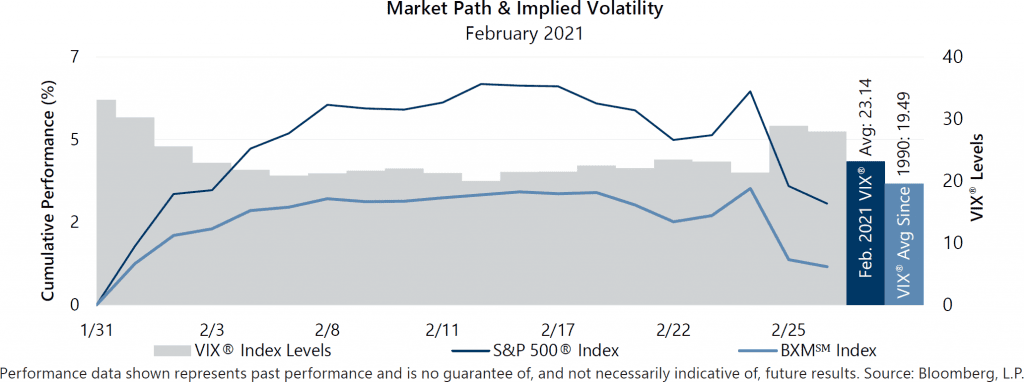The S&P 500® Index climbed 2.76% for the month of February, bringing its year-to-date return to 1.72%. From the start of the month through February 12, the S&P 500® Index climbed 6.01% on positive-trending developments surrounding COVID-19 paired with growing prospects for additional fiscal stimulus. The strong equity market rally was interrupted by increasing concerns surrounding the outlook for inflation and rising interest rates, which led the S&P 500® Index to decline 3.07% from February 12 through month-end.
Macroeconomic data released in February reflected a steadiness in recent trends. The second estimate of Gross Domestic Product for the fourth quarter of 2020 showed that the U.S. grew at an annualized rate of 4.1%, in line with the consensus expectation and slightly better than the prior estimate. The unemployment rate declined from 6.7% in December to 6.3% in January, better than the consensus expectation, while the participation rate ticked down to 61.4%. The December Consumer Price Index, released on February 10, showed a 1.4% year-over-year increase which was in line with the consensus estimate. With nearly 95% of companies reporting, fourth quarter aggregate operating earnings were on track to decline 3.92% quarter-over-quarter and 24.56% year-over-year. More than 81% of the companies that reported earnings met or exceeded analyst estimates.
Implied volatility, as measured by the Cboe® Volatility Index (the VIX®), averaged 23.14 in February. Consistent with its normal relationship, average implied volatility exceeded realized volatility, as measured by the standard deviation of daily returns for the S&P 500® Index, which was 14.27% for the month. The VIX® opened February at its intra-month high of 30.24 then drifted to its intra-month low of 19.97 on February 12 during the equity market advance. As the market declined through the end of February, the VIX® climbed to close the month at 27.95. The VIX® remained above its historical average of 19.49 throughout the month.

The Cboe® S&P 500 BuyWriteSM Index1 (the BXMSM) returned 1.04% in February, underperforming the S&P 500® Index by 172 basis points (bps) and bringing its year-to-date return to 1.15%. On the third Friday of each month, the BXMSM writes a new index call option as the option it wrote the previous month expires. The premiums the BXMSM collects on its written index call options have significant influence on its return potential during market advances and help to mitigate market declines. The premium the BXMSM collected in January helped it return 3.06% from the beginning of the month through February 18, but the premium was not enough to keep pace with the advance of the equity market as the BXMSM lagged the 5.48% return of the S&P 500® Index by 242 bps. On February 19, the BXMSM wrote a new index call option with a March expiration as its February option expired. The premium collected on the new index call option as a percentage of the BXM’sSM underlying value was 1.60% and it helped provide downside protection as the market declined during the second half of February. From February 18 through month-end, the BXMSM returned -1.96%, providing 62 bps of downside protection relative to the S&P 500® Index return of -2.58%.
The Bloomberg Barclays U.S. Aggregate Bond Index returned -1.44% in February, bringing its year-to-date return to -2.15%. The yield on the 10-year U.S. Treasury Note (the 10-year) started February at its intra-month low of 1.08% before climbing above 1.50% for the first time since February 2020 and reaching an intra-month high of 1.52% on February 25. The yield on the 10-year closed the month at 1.41%.
1The BXMSM is a passive total return index designed to track the performance of a hypothetical buy-write strategy on the S&P 500® Index. The construction methodology of the index includes buying an equity portfolio replicating the holdings of the S&P 500® Index and selling a single one-month S&P 500® Index call option with a strike price approximately at-the-money each month on the Friday of the standard index-option expiration cycle and holding that position until the next expiration.


